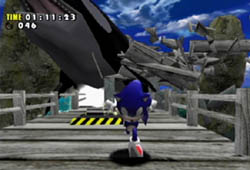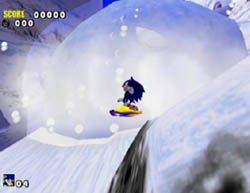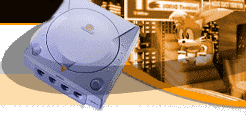| |
Sonic Adventure
A next generation 3D platform experience - Review By BenT
 Yuji Naka and his Sonic Team set the gaming world on fire in 1991, with the
release of Sonic the Hedgehog for Sega's 2 year old 16-bit system, the Sega
Genesis. This landmark title blew gamers away with its trademark, blinding
fast speed and its hip, irreverent main character. (Hey, the attitude
stuff was actually quite novel back then.) Because of the original's
success, it was inevitable that a number of sequels were to follow. Each
Sonic game was a larger hit than the last. Sega had finally found their
mascot. Times changed, and the Genesis was phased out in favor of Sega's
next generation system, the Saturn. Late in the system's life, three games
featuring Sonic did appear, but none were a true sequel to the 16-bit
franchise. In this sense, Sonic and friends never did make a true
transition to the 32-bit Saturn, and to this day the reasons are
unknown. Perhaps an A+ Sonic title could have given the Saturn the kick in
the pants it needed to survive, much like the original game did for
Genesis. We'll never know. Yuji Naka and his Sonic Team set the gaming world on fire in 1991, with the
release of Sonic the Hedgehog for Sega's 2 year old 16-bit system, the Sega
Genesis. This landmark title blew gamers away with its trademark, blinding
fast speed and its hip, irreverent main character. (Hey, the attitude
stuff was actually quite novel back then.) Because of the original's
success, it was inevitable that a number of sequels were to follow. Each
Sonic game was a larger hit than the last. Sega had finally found their
mascot. Times changed, and the Genesis was phased out in favor of Sega's
next generation system, the Saturn. Late in the system's life, three games
featuring Sonic did appear, but none were a true sequel to the 16-bit
franchise. In this sense, Sonic and friends never did make a true
transition to the 32-bit Saturn, and to this day the reasons are
unknown. Perhaps an A+ Sonic title could have given the Saturn the kick in
the pants it needed to survive, much like the original game did for
Genesis. We'll never know.
Thankfully for Sonic fans, those dark times appear to be behind us with the
debut of Sonic Adventure on the Sega Dreamcast. Making the leap to full,
glorious 3D, Sonic has never looked better. But does it live up to the
high standards set by its illustrious predecessors?
The Good

Sonic's Adventure's graphics are a great showcase of the Dreamcast's power. |
The first thing you'll notice when playing Sonic Adventure are the
graphics; they are, in a word, gorgeous. Never before has such a fully
realized 3D world been portrayed in a video game, be it in the arcade or
otherwise. The colors are bright, the framerate smooth, and the resolution
high. Along with sharp textures and detailed environments, Sonic
Adventure is an excellent showcase for the Dreamcast's graphic potential.
The second item you'll note is the music. Depending on your tastes, the
soundtrack is either a glorious triumph in video game cheese or .. well,
just cheese. Yes, Sega has gone nuts on the Sonic Adventure score, and its
easily their wackiest effort since NiGHTS or Daytona USA. Each of the main
characters have their own theme music, most complete with inspired vocals
that push the songs to new heights of Japlish glee. Knuckles even raps
for us. Could you ask for more? Well, yes. In addition to the great
character themes, each stage and sub-stage of the game has its own distinct
redbook audio track. These encompass a variety of styles, from rock to
piano to ancient Mayan-themed. Most are excellent, and add a veritable ton
of appeal to the game.
Great graphics and sound aren't worth much if there's not much to actually
do. Luckily, Sonic Team has this covered. In addition to the main goal
of simply getting through each level, you must perform additional (and
often difficult) tasks to gain up to 120 Sonic Emblems, which are basically
the Sonic equivalent of the stars in Mario 64. Although the main quest
belongs to Sonic, you can also unlock 5 other characters as you play, who
each have their own portion of the story that you can experience from their
point of view. Each stage also offers them different goals than Sonic,
from winning a sandboarding slalom to playing a futuristic version of
whack-a-mole. The 5 extra characters add immensely to the replayability of
the game, and only through playing with all the characters can you unlock
the true ending to the game.

Whether you're snowboarding through an avalanche, running down the side of a building, or trying to escape a vicious hurricane, there's a ton of cool stuff to see and do in Sonic Adventure. |
The level design is absolutely, positively awesome. Gamers have never seen
environments like these before, and it's a joy to see what innovative
detail the designers have put around each corner. The Ice Cap caverns are
vast, the Egg Carrier is awe-inspiring, and Emerald Coast makes you want to
take a trip to a real-life beach. The speeds you achieve and the worlds
you race through are almost unbelievable, and often had me near-bursting
with gaming joy. I mean, what do other games have to offer that can
compare to the level where you dash vertically down the side of a
skyscraper while dodging treacherous, slicing helicopter blades? Or the
one which has you running for your life along a boardwalk as a huge whale
leaps out of the water and continually smashes it right behind you? The
answer, right now, is nothing. This is great stuff, folks.
Another interesting feature of Sonic Adventure is the built in A-Life
system. A-Life is a unique innovation that was first seen in Sonic Team's
Saturn title NiGHTS. In that game it was rather simple; a number of
virtual creatures called Nightopians inhabited the worlds of the game, and
your actions around them affected their emotions, either positively or
negatively. Eventually, if all went well, they would breed and new species
of Nightopians would emerge. Yay. While it was certainly an original
idea, the implementation really left me cold. Thankfully, the A-Life
system in Sonic Adventure is about 1000 times better. It revolves around
creatures called Chao (pronounced "chow") that can be hatched from eggs at
three different points in the game. After hatching, it's your task to
raise and take care of them, which involves feeding them and hugging them
often. You can also export your Chao to a VMU mini-game in which the Chao
goes on an adventure, acquiring items and battling a few enemies along the
way. All of this effort on your part will make your Chao gain strength and
increase its basic attributes such as running, flying and swimming. These
stats come into play when you decide to enter your Chao into one of several
Chao races. Success here will earn you a few Sonic Emblems, but the real
reward is the satisfaction in knowing that your Chao kicks ass. All in
all, A-Life is an excellent addition to Sonic Adventure. While it's
certainly not for everyone, it's varied and interesting enough to at least
warrant a few hours of experimentation.
Finally, Sonic Adventure is the first internet-enabled Dreamcast title. By
choosing the Internet option from the main menu, you can connect to a
custom Sonic Adventure website that is available exclusively to users of
the game. Among the more interesting activities here are trading Chao with
other people, and the ability to download custom addons for that enhance
parts of the game. For example, the (only) download currently offered
spruces up the game's main hub with balloons and banners celebrating the
Dreamcast launch. By mid-October Sega also hopes to have a world ranking
system set up, so players can compare their times on levels with people
from all over the world. This should be great.
The Bad

The voice acting and dialogue isn't the greatest. |
One of the few highly annoying traits of Sonic Adventure is the huge amount
of bottomless pits you encounter. Pits are definitely the #1 predator in
this game, which annoys me because for some reason I'd rather die from an
enemy than a crevice. While pits are nothing new to video games, and
something you've surely conquered in the past, it's the next flaw that
makes them worse.
Basically, the collision detection between your character and the world is
sometimes a little wonky. If you run into a barrier at just the right
angle, and just the right speed, you very well may pop right through it and
end up plunging into the abyss. Or worse, sometimes you're just jumping
around trying to get somewhere when the wackiness kicks in, sending you
through your intended landing point and, you guessed it, into the
depths. This is not an ultra-common occurrence, but it happened enough at
certain points in the game to seriously annoy me.
Another largish flaw is that about 5-10% of the time, the camera is just
annoying as hell. Whether it's not being able to view a room the way you'd
like, or it rapidly switching perspective at just the wrong time, the
camera is sure to get on your nerves at least once in a
while. Unfortunately, the camera sometimes decides to pull some of its
nasty tricks in areas that are rife with the aforementioned pits. As you
might imagine, it's rather jarring when you're in midair over an abyss and
the camera suddenly pulls a 180! Argh! Still, some of the camera and
collision issues were cleared up for the US version of Sonic Adventure, so
we should at least consider ourselves lucky that we're not playing the
original Japanese version.
This brings me to the voice acting. If I had to describe my thoughts on
the English voice acting in a haiku, this is how it might go:
The English speech bites
Where does Sega get these
guys?
Speak Japanese, please.
Yes, Sonic Adventure lets you choose to play with the original Japanese
dubbing and English subtitles, and needless to say, the Japanese voice
acting is a lot better. So, this bad point is actually pretty much
negated, unless you insist on having spoken English dialogue. Kudos to
Sega for giving us the choice, which is something of a rarity.
Finally, if you haven't grasped it from the rest of the review, this is a
platform-centric title that has heavy Japanese influences. If American
games like NFL2K and Hydro Thunder are the reason you bought your
Dreamcast, or you just don't enjoy platformers, then you might not find
Sonic Adventure too appealing.
The Final Word
Sonic Adventure is a creative triumph, easily surpassing all other titles
as the current king of 3D platform games. The style and scope of this game
are breathtaking, and proof positive that Sega is back on track. If they
can keep up this level of output, I can't imagine what might lie in store
next. Bring it on.
Developer: Sonic Team
Publisher: Sega
Genre: Platform
Highs: Beautiful graphics, mindblowing speed, decent control, awesome
soundtrack, excellent replay value, Internet ranking (soon).
Lows: A-Life can take up most of a VMU, occasional camera and clipping
issues, framerate drops briefly in a few spots.
Other: 1 Player, VMU Compatible (for saving progress and Chao mini-games), Jump Pack Compatible, Uses Modem.
|
Final Score:

(out of a possible 10)
|
Visit this Game's Dreamcast Database Entry
Previous Reviews
Comments on this review? Mail Feedback.
|

